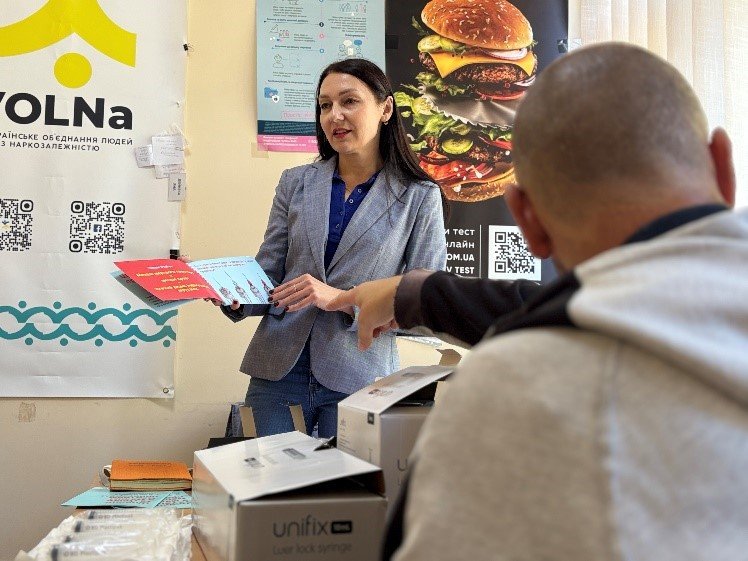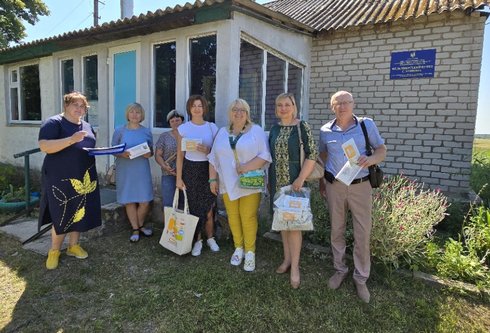In the shadow of war, where uncertainty has become routine, a quiet yet vital public health effort continues every day. Just 20 kilometers from the front line in eastern Ukraine, medical workers, social workers, peer counselors, and harm reduction specialists risk their lives daily to provide prevention, treatment, and support services for viral hepatitis, HIV, and opioid substitution therapy (OST).
The “peer-to-peer” approach is crucial. Social workers who have overcome drug dependency challenges themselves become guides for others. Their work is not just about testing, counseling, or prevention; it’s about giving people the chance to feel seen and experience hope. They lead prevention efforts, conduct testing, provide counseling, and act as a source of support.
Yana Deyneka is a peer worker in Sumy with VOLNA, the Ukrainian Network of People who Inject Drugs. Describing her job, Yana said: “We don’t just hand out syringes. People come to us for conversation, advice, a kind word, a smile. This isn’t just a job…often, we hear stories people don’t even tell their closest loved ones. And then comes the hardest part—finding words or solutions that support without causing more harm.”
Amid prolonged war and systemic pressure on the health care sector, health care providers and the Ukrainian health care system continue to adapt, respond to challenges, and maintain resilience. Prevention and treatment programs for people who inject drugs have remained stable for many years, meeting basic needs.
Thanks to the strategic vision of the Public Health Center of the Ministry of Health of Ukraine, people can access free treatment for hepatitis C (HCV) even during wartime.
However, today’s challenges—including full-scale war, economic instability, and changing client needs—require flexible, complementary solutions that operate directly within communities, respond quickly to requests, and provide individualized care.
The HCV Combination Prevention in People Who Inject Drugs and Prisons (HepC3P) project, implemented by PATH with funding from Unitaid, is responding to these challenges. In partnership with national institutions and civil society organizations, the goal of HepC3P is to accelerate access to innovative and underutilized medical products for HCV prevention and diagnosis among people who inject drugs and prisoners in Ukraine, employing an approach that puts communities at the center of research, implementation, and decision-making.
The human face of harm reduction
In Sumy, at the local drug dispensary on the outskirts of the city, there’s a harm reduction office. Yana, the peer worker, hurries to work.
Outside the building, many people have already gathered. Inside the small office, every centimeter of space matters. Sterile syringes, alcohol wipes, condoms, and rapid tests for HCV and HIV are carefully arranged.
On the tables are folders with questionnaires, medical forms, and reports. This is not just a workplace, it’s a place of response and support.
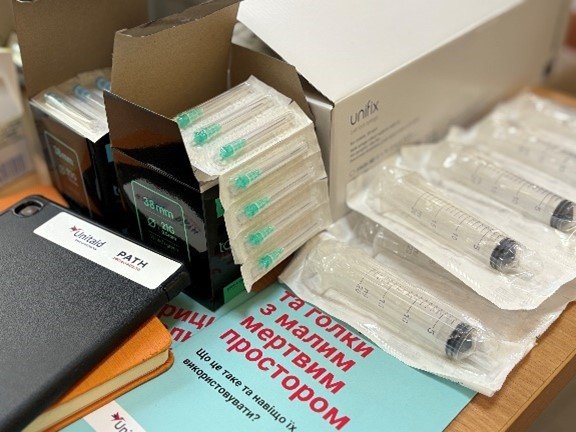
Low dead-space needles and syringes provided at harm reduction offices. Photo: PATH.
As soon as a familiar face appears in the window, Yana already knows what to prepare. Some clients always ask for a test, others for syringes, and some just need tea and a few words of encouragement. In these moments, trust is born. And trust is the foundation of the systemic change the HepC3P project aims to achieve.
Yana explains: “I know I can’t save everyone. But every day someone gets tested, receives medication, feels cared for, or simply smiles—that’s a victory. And then it’s clear: my work matters. It’s for these small victories that I come here again and again, even when the sky roars and explosions thunder nearby. Because as long as we’re here, as long as we hold each other—life goes on.”
Combined prevention strategies for HCV
At the heart of the HepC3P approach is combined prevention, which integrates biomedical, behavioral, and structural interventions to prevent HCV transmission. The project also actively promotes community participation mechanisms in the design, implementation, and monitoring of services, enhancing the effectiveness of interventions and ensuring sustainable change.
“HCV directly affects our community—more than every second person has or had it...until HCV starts showing symptoms, people often ignore it. Even when we seek help, we mostly face expensive diagnostics, long waits for treatment.”— Oleh Dymaretskyi, Director of VOLNA
At the same time, the effectiveness of HCV treatment largely depends on participation in another program—OST, which helps stabilize health, move away from street drugs, and focus on recovery.
The successful implementation of combined prevention within the HepC3P project is based not only on principles of integration and community involvement but also on the introduction of specific interventions that are proven effective, meet current challenges, and support sustainable health care system development.
Innovations that transform access
One of the key HCV prevention tools being evaluated through HepC3P is long-acting depot buprenorphine (LADB). LADB differs from other opioid agonist therapies in that it only requires a once-monthly injection, offering a more convenient option to clients who previously needed to come to a facility daily or weekly to get medication.
LADB was briefly available previously in Ukraine through international donations coordinated by the Public Health Center of the Ministry of Health and showed impressive results: it has helped many clients reduce street drug use, complete treatment, stabilize their lives, and return to social activity.
It has the potential to both reduce relapse risk and improve treatment adherence.
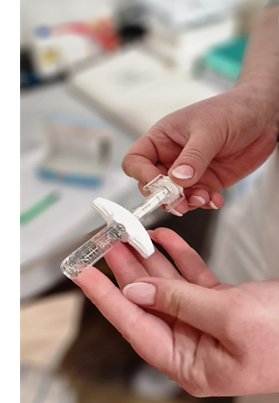
LADB monthly dose injection. Photo: PATH.
HepC3P study findings on the acceptability, feasibility, effectiveness, and cost-effectiveness of LADB will contribute to national and global guideline updates and policies on best practices for harm reduction. Expanding access to LADB through these updates offers a chance to make treatment more personalized, increase treatment effectiveness, and strengthen the resilience of the health care system.
For OST clients, this means fewer interruptions, access to modern treatment regimens, and additional social support—all contributing to better quality of life.
“Thanks to LADB, I no longer need to carry my prescription or other documents to prove I’m on OST. Even during police checks, there’s no reason to hassle me. It’s not just stability, it’s a sense of freedom and control over my life.”— OST client
HepC3P is also conducting research to evaluate the feasibility and acceptability of introducing low dead-space needles and syringes, recognized by WHO since 2012 as an effective prevention tool for HCV and HIV.
The project is using a community-led research approach, supported through an information campaign, to learn more about clients’ needle and syringe preferences and the potential for low dead-space products to prevent HCV and HIV transmission.
Community as a driver of change
The HepC3P project is built on the principle of community participation, especially people with experience of drug use. Peer counselors don’t just share information, they take an active role in project monitoring and advocacy. Their involvement helps tailor services to real needs, raise awareness about HCV, reduce stigma, and ensure effective introduction of new HCV prevention tools.
Janneta Matveiko, a peer counselor, explains: “I went from addiction to recovery. Now, as a peer counselor, I help others walk that path without fear or shame. I know what they’re going through because I’ve been there. For me, this isn’t just a job—it’s my mission.”
In partnership with the VOLNA, the project supports community capacity development, promotes data-driven policymaking, and ensures sustainable change.
At the same time, no intervention can be effective without trust.
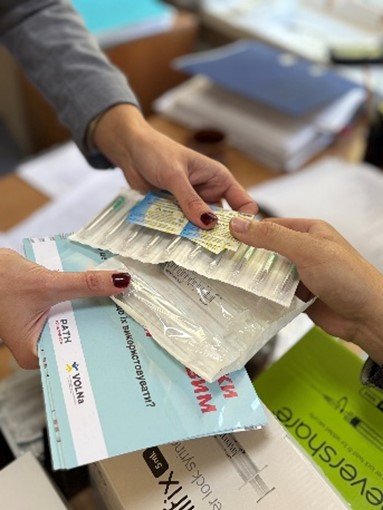
A peer worker, who also serves as a community researcher on the HepC3P study, provides HCV prevention products to a client: sterile low dead-space syringes and needles, an informational booklet, and alcohol wipes. Photo: PATH.
“This isn’t just about access to services. It’s about recognizing that communities are key partners in shaping responses to challenges.”— Vielta Parkhomenko, HepC3P Community Advisory Board member
HepC3P is not just about treatment. It’s about recognizing lived experience and investing in the people who keep the system afloat every day. And it’s thanks to projects like HepC3P that even in the most difficult times, peer support and community leadership make change possible.
